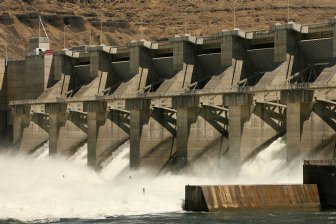forum
library
tutorial
contact

Some Agencies Want 10-Year
Spill 'Test' in Next F&W Program
by Bill Rudolph
NW Fishletter, October 14, 2013
|
the film forum library tutorial contact |

|
Some Agencies Want 10-Year
by Bill Rudolph
|
 Although NOAA Fisheries has already explained why it's not interested in adding more spill at federal dams, several other federal and state agencies in the Columbia Basin are calling for just that -- a 10-year spill "test" that would considerably boost dissolved gas levels at Columbia and lower Snake River dams, and fish returns as well, according to the analysis they are using to peddle the proposal.
Although NOAA Fisheries has already explained why it's not interested in adding more spill at federal dams, several other federal and state agencies in the Columbia Basin are calling for just that -- a 10-year spill "test" that would considerably boost dissolved gas levels at Columbia and lower Snake River dams, and fish returns as well, according to the analysis they are using to peddle the proposal.
The so-called spill test was included in a group of proposals from the Oregon Department of Fish and Wildlife and the U.S. Fish and Wildlife Service, part of their contributions to the ongoing process of amending the Columbia Basin's F&W program that is being overseen by the Northwest Power and Conservation Council.
The spill test was described at the September Council meeting by USFWS biologist Steve Haeseker. He presented the CSS [Comparative Survival Study] analysis developed by some tribal, state, and federal scientists that suggested boosting spill to a level that produced 125-percent total dissolved gas could increase smolt-to-adult returns for ESA-listed salmonids to recovery levels of around 4 percent.
Other groups that supported the spill test in their recommendations to the Council included the Pacific Fishery Management Council, American Rivers, Save Our Wild Salmon, The Northwest Sportfishing Industry Association, and the Nez Perce Tribe.
NOAA took a dim view of Haeseker's spill analysis in its draft BiOp released Sept. 9. The feds said the data used to construct his spill model used a timeframe that captured only one year of increased spill. Since then, spill levels have increased at some projects and its efficiency has improved with the addition of spillway weirs.
The agency also said its own unpublished data showed conventional and surface spill passed a larger portion of fish for a fixed spill percentage at lower flows than at higher flows. And the agency pointed to a recent analysis (Skalski et al.) of the Haeseker study that suggested the correlation between higher spill levels and better adult returns was highly suspect, since the spill percentage also correlated with increased adult returns of transported fish, which didn't benefit from it.
The feds also pointed out that the CSS model left out a variable for total dissolved gas, which would not include higher levels of fish mortality at higher levels of spill. But they also said more years of operation under the current system will add enough data to determine if the CSS hypothesis is right.
In the last amendment process, completed in 2009, the Council voted 6-2 against adding more flows or spill provisions to the F&W program. Only Oregon members supported it. But this time around, the vote could be different.
Council watchers say Montana members seem more closely aligned with Oregon's two members, who will likely vote pro-spill. Washington's own representatives could split on it, and the state would have to amend its current dissolved gas waiver that allows tailrace TDG levels of 120 percent, before it could go forward. But there is little chance that NOAA would approve such a change in operations.
Washington member Tom Karier said the Council was going to take some time to consider it all, and did not want to speculate on the future of the spill recommendation. Karier had asked Haeseker some tough questions about his spill analysis at the September Council meeting.
Idaho members are not expected to favor the spill test either, so it may be tough to get it into the next F&W program, since such amendments require a supermajority -- a majority of the members, including at least one member from each state, or the affirmative vote of at least six members.
It was reported that representatives of American Rivers have approached Council members on the spill issue and suggested that if they supported the spill recommendation, plaintiffs in the ongoing hydro litigation might not haul federal agencies back into court over the newest BiOp, which is scheduled to be completed by the end of the year.
If the spill recommendation does become part of the new plan, then BPA would likely have to give it serious consideration. If it doesn't get into the new plan, then plaintiffs could sue the Council, or Action Agencies, or the National Marine Fisheries Service if it isn't included in future dam operations.
learn more on topics covered in the film
see the video
read the script
learn the songs
discussion forum
